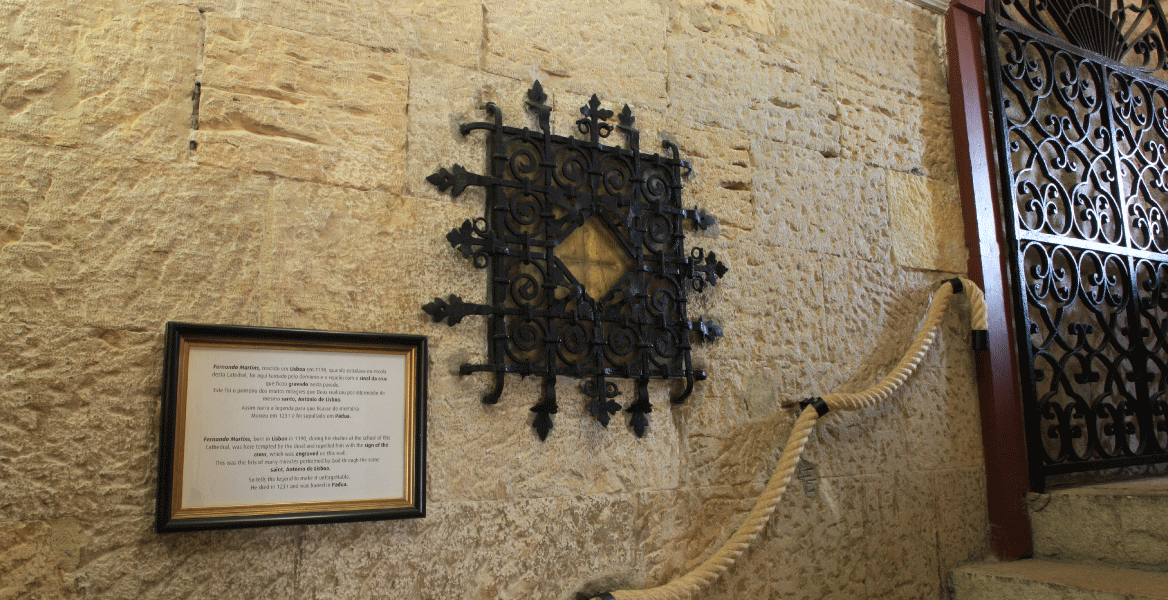Lisbon Cathedral
The church that saw Saint Anthony grow
and keeps the relics of Saint Vincent
To visit the Cathedral of Lisbon is also to be in communion with the saints who are part of the history of this temple, of the Diocesan and Universal Church. Above all, Saint Mary Major, patron saint of this Cathedral and of the Parish, and particularly Saint Anthony, patron saint of the city of Lisbon, and St. Vincent, patron saint of the Patriarchate.
Saint Anthony
St. Anthony was born a stone’s throw from the Cathedral, between 1191 and 1195, where he lived until he was 15 years old with his parents and sister. No wonder, therefore, that the link of Lisbon’s most popular saint to his Cathedral is so strong. Here he received baptism, attended his first studies and joined the choir.
While visiting the Cathedral it is possible to appreciate the magnificent interior of the baptistry that welcomed the most renowned Portuguese saint in the world. Covered with 18th century tile panels, countless illustrious personalities from Portuguese history have been baptized here.
Another sign of the passage of Saint Anthony through the Cathedral of Lisbon can be found on the wall of the staircase leading to the high choir: the famous cross of Saint Anthony. Legend has it that when he was a child and studied at the school of this Cathedral, St. Anthony was tempted by the devil in this place, and repelled him by drawing the sign of the cross that was engraved here. This was the first of the many miracles that God performed through the saint born in Lisbon in 1190.
But there are also legends that St. Anthony was an excellent conciliator of couples, having become popularly known as a holy matchmaker. This fame was at the origin of the creation of Marriages of St. Anthony, an initiative that first took place on June 12, 1958, with the aim of offering a marriage to couples in financial difficulties, and which became an annual tradition, already part of the cultural identity of the city.
After April 25, 1974, the event – which is promoted by the City Council of Lisbon – was cancelled for 23 years, having been resumed in 1997. The civil ceremonies take place in the Town Hall and the religious ceremonies in the Cathedral of Lisbon.

Saint Vincent
Less popular, but no less important than St. Anthony, is Saint Vincent, also with a very special connection to the Cathedral and the Diocese of Lisbon. Legend has it that in the 4th century, deacon Vincent of Zaragoza was tortured to death by Emperor Diocletian for refusing to offer sacrifices to the pagan gods. With the Muslim invasion, his remains were placed on a boat adrift at sea, which would later reach the coast at Cape Sagres.
Already in the 12th century, the first king of Portugal, D. Afonso Henriques, promised to recover the bones of the martyr Saint Vincent if he conquered Lisbon. He did so in 1173, and it is said that two crows protected the boat during the return trip to Lisbon. Saint Vincent became the patron saint of Lisbon, while the crows and the boat became the symbols of the capital.
According to a text written at the end of the 12th century by Master Estevão – master of the choir of the Cathedral of Lisbon –, an anonymous man had, in 1173, alerted for the fact that the body of Saint Vincent was at Cape St. Vincent, in Sagres. The relics of the saint would be in the so-called “church of crows”, but according to the cleric the initiative to go and get them came from some inhabitants of the city, who went by sea to Sagres after having obtained information about the tomb of St. Vincent from Algarve Mozarabs.
Upon arrival in Lisbon, three rival groups disputed the relics of Saint Vincent: the group of the Mozarabs wanted to take them to the Church of St. Justine, as a way of appropriating themselves of an important cult; the followers of the rules of Saint Vincent wanted them in the Monastery of St. Vincent; and the Cathedral priests proposed as an alternative their own Cathedral, where they effectively rest since September 16, 1173. The saint thus became patron of the Diocese of Lisbon, and his memory is evoked by the Church on January 22, the day of his death (which took place in the year 304).
The reliquary coffer containing the relics of the martyr Saint Vincent is amongst the most relevant objects on display in the Treasury of the Cathedral, from a symbolic and religious point of view. The relics continue to be venerated on the day of his liturgical solemnity, and in the annual Eucharist that is celebrated in the Cathedral the chalice and paten of St. Vincent, also exhibited in the Treasury, keep being used.


